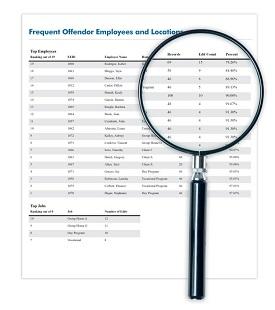Managing limited resources is a full-time job for many provider executives. To do so efficiently, you need metrics based on reliable and timely data to identify avoidable costs or revenue losses. Paper timesheets are obviously very vulnerable to fraud, but even providers using a general purpose time and attendance system (especially one that doesn’t provide the proper controls) risk losing thousands of dollars due to fraud.
Provider Loses $920,004 in Time and Attendance Fraud, 41 Employees Arrested
 In January of 2019, 41 individuals were charged in a nearly one-million-dollar overtime kickback scheme at a provider of I/DD and behavioral health services. The shady conduct carried on for 21 months before external accountants spotted a massive payroll leak. The agency was using a general purpose time and attendance system from its payroll provider.
In January of 2019, 41 individuals were charged in a nearly one-million-dollar overtime kickback scheme at a provider of I/DD and behavioral health services. The shady conduct carried on for 21 months before external accountants spotted a massive payroll leak. The agency was using a general purpose time and attendance system from its payroll provider.
Four supervisors were detained in prison on bail. The supervisors manually altered time and attendance records to inflate hours worked, resulting in overtime payments to employees, who in return, provided kickbacks to the supervisors (including a used BMW). Individual employees received overpayments up to $22,117 during the period of the scam.
The problem appears to result from lack of attention or ability to track hours worked vs. budget on a pay-period-to-pay-period basis by group home or other cost center and the percentage of edits.
Payroll leakage can be minor, or like in this case, massive! Luckily, your agency can take action to reduce this risk, allowing you to put that money towards providing services to the vulnerable populations you serve, not in the pockets of unscrupulous employees.
 Two Operational Metrics To Monitor to Avoid Time and Attendance Fraud
Two Operational Metrics To Monitor to Avoid Time and Attendance Fraud
Checking these two metrics every pay period can help minimize the financial risks of time and attendance fraud. Even providers with manual timesheets can use these metrics!
Compare actual hours worked vs. operational budgets for each unit (group home, day program, HCBS client). If the hours worked exceed the operational budget, the reason could be attendance violations or fraud consisting of the following:
- Overlapping shifts
- Unauthorized attendance
- Buddy punching
- Time and attendance fraud by supervisors
Track the percentage of attendance edits. Ideally edits should be less than 10%. An excessive percentage of manual edits usually equals a percent of time and attendance fraud (employees deliberately “forgetting” to clock in/out, or managers collaborating with fraud, as in our case study). While some level of editing is inevitable, as some employees will always genuinely forget, the percentage should not be above 10%. Edits exceeding 10% would indicate:
- Some employees are deliberately “forgetting” to clock-in/out when late or leaving early.
- Supervisors are colluding with employees to provide extra pay for time not worked.
Often the employees or supervisors engaging in these practices are isolated to a small group. Therefore, it makes sense to track “frequent offenders” at the employee and supervisor level.
*It should also be noted that the percentage of attendance edits can also be used to trigger audits or to withhold reimbursement in Texas and Louisiana EVV programs.
Four Additional Tips to Improve Time and Attendance Security
- If using telephone timekeeping, track employees who called from unrecognized locations (caller-ID) or block calls without a valid caller-ID number.
- If using mobile phones, track the IP and GPS addresses and use geo-fencing or out-of-area alerts. Employees are unlikely to give their smartphone to another employee, but they may share credentials.
- If using shared PCs for employees to clock in and out, ensure only PCs with a valid IP address are used and implement an automated change password systems. Shared PCs are vulnerable to buddy punching.
- Use biometric fingerprint readers at locations with multiple employees.
Conclusion
Key operational metrics can play a major role in a provider’s efficiency and how they can help executives pinpoint problem areas. It is important for providers to track these metrics regularly (weekly or daily) to catch issues before they undermine your agency’s budget. Irrespective of what system your agency uses for time and attendance, these two metrics will help make sure your system is not leaking payroll.
 John Graham is CEO and Software Architect of MITC Agency Workforce Management. As CEO, John has partnered with providers throughout the United States to deliver the most cost-effective and affordable solutions that result in reduced payroll costs, increased productivity, and compliance with state and DOL regulations. Visit www.mitcagencies.com or contact [email protected] to learn more.
John Graham is CEO and Software Architect of MITC Agency Workforce Management. As CEO, John has partnered with providers throughout the United States to deliver the most cost-effective and affordable solutions that result in reduced payroll costs, increased productivity, and compliance with state and DOL regulations. Visit www.mitcagencies.com or contact [email protected] to learn more.
